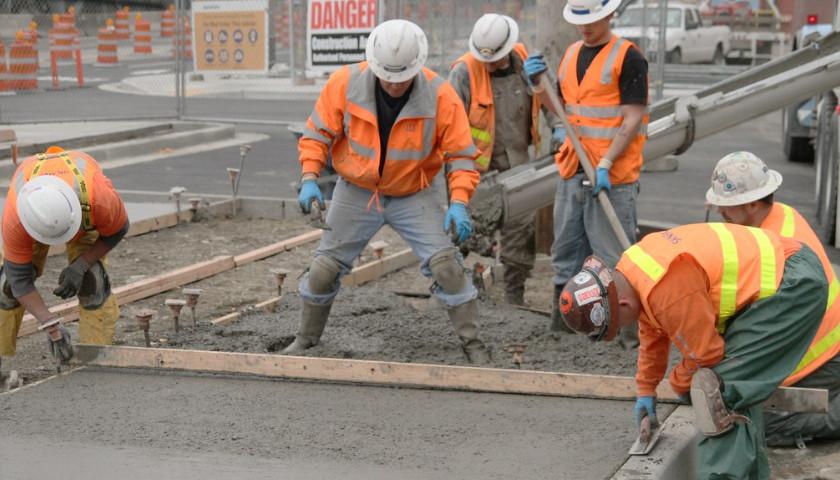The Tennessee Advisory Commission on Intergovernmental Relations (TACIR) announced last week the release of its 21st annual report on the public infrastructure needs across the state during the five-year period of July 2021 to June 2026.
The latest report, “Building Tennessee’s Tomorrow: Anticipating the State’s Infrastructure Needs,” indicates there is $1.2 billion or two percent increase over the year before. And while the costs have increased for the seven straight reporting period, they decreased when adjusted for inflation and population.
Since TACIR’s 2019 report, covering July 2017 to June 2022, the estimated funding for infrastructure needs has grown $49.8 billion or 26 percent.
Meanwhile, Tennessee state budget documents show that proposed spending has increased by more than 40 percent over the past five years, while the same documents indicate the population growth in the state, recorded with a two-year delay, has been four percent.
Over the past five fiscal years which runs from July 1 through June 30, the state has collected about $9 billion in surplus taxes and fees over the original budgets. In the current fiscal year, the surplus is $1.17 billion through the first six months.
TACIR is a 1978 creation of the state legislature in response to findings that indicated the need for a permanent intergovernmental body to study and take action on questions of organizational patterns, powers, functions and relationships among federal, state and local governments, according to the commission’s website.
Also by state law, TACIR is charged with developing and maintaining an inventory of public infrastructure needs, achieved by working with state and local officials to gather the information.
Estimated costs for infrastructure needs are broken into six major categories, but include subcategories under which TACIR provides more detailed analysis within the report:
- Transportation and Utilities, including Transportation, Other Utilities and Broadband: $35.2 billion
- Education, including Post-secondary Education, School Renovations, New Public Schools and Additions, Other Education, School System-wide: $14.8 billion
- Health, Safety and Welfare, including Water and Wastewater, Law Enforcement, Public Health Facilities, Housing, Fire Protection, Storm Water and Solid Waste: $8.9 billion
- Recreation and Culture, including Recreation, Libraries, Museums and Historic Sites and Community Development: $2.3 billion
- General Government, including Public Buildings and Other Facilities: $1.3 billion
- Economic Development, including Industrial Sites and Parks and Business District Development: $246 million
On a statewide basis, the top three subcategories are transportation at $34.7 billion, post-secondary education at a distant $5.6 billion and school renovations at $5.5 billion in identified infrastructure needs.
TACIR points out that transportation needs alone, representing more than half of the $62.9 billion total, are funded primarily thorough state and federal governments.
Transportation was listed as the number one need, in terms of dollars, in all but 10 of Tennessee’s 95 counties, and in only one of those 10 counties was transportation then not identified as the second or third highest infrastructure need.
Of the 10 counties where transportation is not the highest funding need, law enforcement funding needs was first in three counties, recreation needs first in two counties, water and wastewater needs first in two counties, post-secondary education needs first in 2 counties and new public schools & additions in one county.
Post-secondary education, the second highest in terms of funding needs, appeared first in two counties, second in nine counties and third in eight counties.
School renovations appeared second on the list in 14 counties and third in 19 counties.
For more about half, or 47 of Tennessee’s 95 counties, water and wastewater was either second or third in terms of their funding needs.
Twelve other subcategories appeared second or third in terms of funding needs in the following number of counties:
- New Public Schools & Additions – 28 totaling $286 million for new schools and $118 million for additions to existing schools
- Recreation – 19
- Community Development – 5
- Industrial Sites and Parks – 5
- Public Buildings – 3
- Other Utilities – 3
- Public Health Facilities – 2
- Storm Water – 2
- Other Education – 1
- Housing – 1
- School System-wide – 1
- Libraries, Museum & Historic Sites – 1
Even though every subcategory had some identified funding need, subcategories that didn’t make the top three list of funding needs for any Tennessee county included fire protection, other facilities, solid waste, business district development and broadband.
TACIR explains that broadband needs include only projects owned by government entities and, therefore, does not reflect the need for access within the community which relies more heavily on privately-owned utilities.
Local officials report their needs without any constraints of a needs assessment and are limited only by the broad purpose of “public infrastructure.” They are also not compelled to report their needs, even though TACIR is required by law to put the annual report together.
TACIR also incorporates capital improvement requests from state officials, bridge and road needs from TDOT and capital projects from the Tennessee Board of Regents, although other state needs are not included in the report.
The report only includes projects that are in the conceptual, planning and design or construction phases at some point in the five-year period of July 2021 through June 2026. Projects must also not be considered normal or routine maintenance and, with the exception of technology infrastructure for schools, have a capital cost of at least $50,000.
Information provided by officials indicates that 67.8 percent of the funds required to meet the needs is not available, an increase over last year’s 67.5 percent. TACIR notes that as a project evolves, funding sources are typically identified and pursued.
The government that owns the infrastructure typically funds the bulk of its cost, the TACIR report states, but there are exceptions like transportation, industrial sites and parks, broadband, recreation, storm water, housing, libraries, museums and historic sites that rely heavily on state and or federal government for funding.
And, while a table in the report shows $0 for state funding of new public schools, TACIR indicates that the state’s share of $789 million accounted for half of the capital outlay funding in the 2021-2022 fiscal year for new public schools. Since the funds are not earmarked for that specific purpose, the local education agency (LEA) can use the funds for operating costs rather than new schools, renovations or additions.
While TACIR doesn’t give a total of the decreases in funding needs due to project completions, cancellations or savings, it likely totals in the billions of dollars. However, the decreases have been more than offset by increased costs or newly identified needs.
Presumably also contributing to the growth in the infrastructure needs, TACIR says the information provided to them by local officials is more complete and accurate than ever, as the data collection process continues to improve and participants have become more familiar with the process and supportive of the program.
Additionally, the information provided to TACIR for the report is needed for local governments to access various types of funding, including state and federal grants and, more recently, American Rescue Plan Act (ARPA) of 2021 funds.
In addition to an overview at the state level, the TACIR report includes a summary page for each of Tennessee’s counties, highlighting the top three types of infrastructure needs based on total estimated cost and broken down into conceptual projects and those that are in the planning and design stage or have started construction. The county summary pages also include a graph depicting school infrastructure needs compared to student enrollment.
– – –
Laura Baigert is a senior reporter with The Star News Network, where she covers stories for The Tennessee Star.
Photo “Road Construction” by Washington State Dept of Transportation. CC BY-NC-ND 2.0.






Gosh with all of the tax revenue coming in from online gambling this stuff should be paid for in 3 or 4 months!
Seriously, this is a never-ending cycle. It is like the honey-do lists for homeowners. It only grows as projects are completed. A wise and small government operation will pay for these items as they are done. Of course, Mr. Lee does not operate a small and conservative government. Therefore, I figure his administration will find a way to justify spending loads of money we do not have.
Maybe he will come up with “choice watermains” whereby a customer can guarantee good water pressure in the summer months by simply paying a toll to a private contractor to use their “choice watermain” constructed on public property.
Sounds crazy doesn’t it? But it makes as much sense as “choice toll lanes” on our highways.